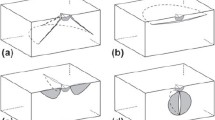Abstract
A test using two wedges splitting a small, doubly grooved specimen allows measurement of stable, fully plastic crack initiation and growth under variable amounts of triaxiality. In wedge tests, 25 mm cubes of 1018 hot rolled steel in three different orientations exceeded the limit load predicted by plastic slip-line fields. The tests gave crack tip initiation displacements of 0.7–0.8 mm, regardless of orientation. Since microscopic examination of the fracture surfaces indicated that the wedges suppress blunting, the presence of non-zero initiation displacements suggests that a fracture process zone of finite thickness must be established before crack growth. During growth, a specimen with rolling direction normal to the crack plane had a crack growth ductility (minimum displacement per unit ligament reduction) of 0.006–0.009, compared to ductilities of 0.016–0.027 for specimens with rolling direction parallel to the crack front or parallel to the growth direction. The lower ductility with the crack normal to the rolling direction appears to be due to a smoother fracture surface without zigzagging between inclusion stringers.
Résumé
L'essai consistant à séparer par deux coins une petite éprouvette à double entaille permet de mesurer l'amorçage stable et totalement plastique d'une fissure et sa croissance sous divers états de triaxialité. On a constaté lors d'essais de ce type que des cubes de 25 mm de côté en acier 1018 brut de laminage présentaient, dans les trois directions caractéristiques, une charge limite en excès par rapport aux prédictions fournies par les champs de bandes de glissement plastique. Les essais produisaient des déplacements de l'extrémité de la fissure à l'amorçage de quelque 0.7–0.8 mm, quelle que soit l'orientation. Un examen microscopique des surfaces de la rupture a révélé que les coins suppriment la formation de cupules; dès lors, la présence de déplacements non nuls à l'amorçage suggère que le processus de rupture à dû se déclencher dans une zone d'épaisseur finie avant que ne croisse la fissure. Au cours de cette croissance, on a constaté qu'une éprouvette dont le sens de laminage était normal par rapport au plan de la fissure présentait une ductilité à la croissance de la fissure de 0.006–0.009, comparée aux valeurs de 0.016–0.027 qu'exhibent des éprouvettes dont le sens de laminage est parallèle au front de fissure ou à la direction de sa croissance (on définit la ductilité à la croissance d'une fissure par le déplacement minimum par une unité de réduction du ligament). La ductilité plus faible constatée pour une fissure normale par rapport à la direction de laminage parait due à une surface de rupture plus lisse, dépourvue de portions en zig-zag entre les inclusions.
Similar content being viewed by others
References
D.P. Clausing, International Journal of Fracture Mechanics 6 (1970) 71–85.
L.M. Barker, Engineering Fracture Mechanics 9 (1977) 361–369.
L.M. Barker, International Journal of Fracture 15 (1979) 515–536.
R. Hill, Journal of the Mechanics and Physics of Solids 1 (1953) 265–270.
F.A. McClintock, Journal of Applied Mechanics 35 (1968) 363–371.
J.W. Hutchinson, Journal of the Mechanics and Physics of Solids 16 (1968) 13–31.
J.R. Rice and G.F. Rosengren, Journal of the Mechanics and Physics of Solids 16 (1968) 1–12.
C.F. Shih, International Journal of Fracture 29 (1985) 73–84.
R.M. McMeeking and D.M. Parks, in Elastic-Plastic Fracture, ASTM STP 668 (J.D. Landes seds) American Society for Testing and Materials, Philadelphia (1979) 175–194.
C.F. Shih and M.D. German, International Journal of Fracture 17 (1981) 27–43.
L.I. Slepyan, Mekhanika Tverdogo Tela 8 (1973) 139–148.
L.I. Slepyan, Mekhanika Tverdogo Tela 9 (1974) 57–67.
P. Ponte Castañeda, Journal of the Mechanics and Physics of Solids, to appear.
F.A. McClintock, in Fracture (H. Liebowitzed) Academic Press, New York 3 (1971) 47–225.
ASTM E399-85, American Society for Testing and Materials, Philadelphia (1985) 547–582.
J.E. Neimark, Journal of Applied Mechanics 35 (1968) 111–116.
R. Hill, E.H. Lee, and S.J. Tupper, Proceedings of the Royal Society (London) A188 (1947) 273–290.
R. Hill, The Mathematical Theory of Plasticity, Clarendon Press, Oxford (1985).
A.P. Green, Quarterly Journal of Mechanics and Applied Mathematics Pt.2, 6 (1953) 223–239.
L. Prandtl, Nachrichten von der Königlichen Gesellschaft der Wissenschaften zu Göttingen, Mathematisch-Physikalische Klasse (1920) 74–85.
G.A. Kardomateas and F.A. McClintock, submitted to International Journal of Fracture.
J.W. Hancock and M.J. Cowling, Metal Science 14 (1980) 293–304.
Author information
Authors and Affiliations
Rights and permissions
About this article
Cite this article
McClintock, F.A., Wineman, S.J. A wedge test for quantifying fully plastic fracture. Int J Fract 33, 285–295 (1987). https://doi.org/10.1007/BF00044417
Received:
Accepted:
Issue Date:
DOI: https://doi.org/10.1007/BF00044417




